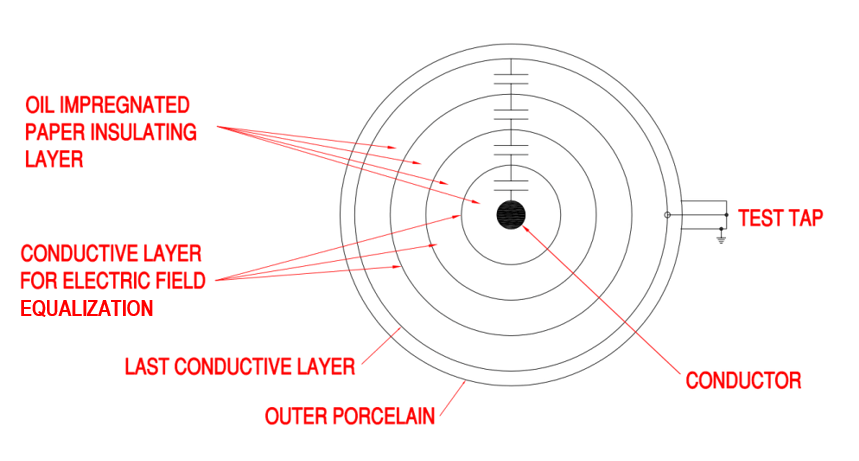Condenser Bushings
At higher system voltages, condenser bushings are used. Compared to bulk type bushings, condenser bushings are relatively complex in their construction. In order to cope with the high electric field stresses generated at high voltage, condenser bushings are formed from an inner capacitance-graded insulated core, which is sandwiched between the central current carrying tube and external insulator.
The condenser core consists of coaxial layers of electrical grade Kraft paper and conducting foil inserts of varying lengths. Foil inserts are located at fixed radial intervals, which aids in distributing and stabilising the electric field across the bushing insulation. These conducting inserts mimic the capacitive elements (connected in series) that link the high voltage conductor of the bushing to ground. For this reason, condenser bushings are sometimes referred to as capacitance-graded bushings.

Cross-Section of Condenser Bushing
To further increase a bushing’s dielectric strength, the condenser insulation is saturated with mineral oil, or curable epoxy resin; these two technologies are referred to as oil impregnated paper (OIP) and resin impregnated paper (RIP), respectively.
The material of the external insulator is invariably porcelain for OIP condensers and silicon rubber for RIP condensers, both serving the same purpose of limiting the flow of leakage current and preventing external flashovers. OIP condenser bushings are also fitted with a spring-loaded expansion chamber to allow for oil volume fluctuations (expansion/contraction) due to varying temperature (a conservator tank on a power transformer performs a similar purpose).

Oil Impregnated Condenser Bushing
Condenser bushing mounting flanges are equipped with a test tap (more on this below) and additional space for the installation of a ring type current transformer (CT). Internal connecting terminals are fitted with stress shields to limit high potential stresses inside the oil-filled enclosure. See our main electrical bushings article for further information.
See our main electrical bushings article for further information.
Want to learn more about electrical bushings?
Then check out our Introduction to Electrical Bushings video course!
How Electrical Bushings Work
The below video is an extract from our Mechanical and Electrical Engineering Explained Online Video Course.
Enjoying this article? Then be sure to check out our Introduction to Electrical Bushings Video Course! The course has a quiz, handbook, and you will receive a certificate when you finish the course. Enjoy!
3D Model Components (Summary)
The 3D model cross section shows all major components, these include:
- Outdoor Terminal
- Top Cap
- Air Vent
- Oil Level Indicator
- Oil Expansion Chamber
- Insulating oil
- Gasket
- Spring
- Porcelain Insulator
- Oil Impregnated Condenser Core
- Conductor
- Test Tap
- Mounting Flange
- Stress Shield
3D Model Components (Detailed)
Outdoor Terminal
The connection terminal connecting the bushing to the grid. Air Vent An air vent or pressure relief device may be fitted here; this particular model has no such device.
Top Cap
The top cap houses the oil expansion chamber and oil level gauge. It also houses the spring used to maintain a constant pressure on the gasket between the top cap and porcelain insulator.
Oil Expansion Chamber
An expansion chamber to allow for oil expansion and contraction due to changing temperature.
Spring
Due to thermal expansion and contraction, a spring is required to maintain pressure on the sealing gasket. Constant pressure on the gasket must be maintained in order to prevent oil leaks, moisture ingress or particle ingress.
Gasket
A gasket used to seal the top cap and porcelain insulator. A constant pressure is maintained on the gasket using a spring.
Insulating Oil
Oil is used as an insulating medium between the conductor and external components.
Porcelain Insulator
Designed to prevent leakage current reaching the grounded item e.g. transformer. The insulator has a large surface area to aid natural cleaning by wind and rain. The large surface area and ribbed shape also provide a comparatively long path to earth.
Oil Impregnated Condensor Core
The oil impregnated paper core is interlaced with conductive material, this arrangement creates a series of capacitors.
Conductor
The flexible cable from the transformer is passed through the conductor. The conductor also allows the spring pressure to be transferred to all joints and gaskets.
Test Tap
A tan delta/power factor/dissipation factor test can be performed here in order to assess the condition of the condenser core.
Mounting Flange
A flange connecting the bushing to the transformer casing.
Current Transformer Extension
A current transformer can be installed here if required.
Oil Side Porcelain Insulator
This section of the porcelain insulator is submerged in oil.
Related Online Engineering Courses
Introduction to Electrical Transformers
How Electrical Transformers Work
Electrical Transformer Health Assessment
Why Are Transformers Rated in VA not W?
Additional Resources
https://www.electricalindia.in/condenser-bushings
https://en.wikipedia.org/wiki/Bushing_(electrical)
https://www.sciencedirect.com/topics/engineering/bushings
https://testguy.net/content/257-high-voltage-bushing-maintenance-techniques
